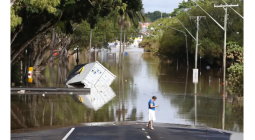IPCC, methane and carbon offsetting: Cop27 jargon buster

World leaders meeting for UN climate talks in Egypt are under pressure to take action. Here are some commonly used terms and what they mean
Cop
Cop27 will be the 27th conference of the parties to the UN framework convention on climate change, the parent treaty to the 2015 Paris agreement. While last year’s Cop26 was higher profile, with 120 world leaders and about 40,000 delegates attending, this year’s will have fewer key decisions to make. However, it is no less important: by 2030 the world must cut emissions by about half, compared with 2010 levels, to stave off the worst ravages of climate breakdown, and this means every Cop is vital.
This year, countries will be aiming to make progress on climate finance and helping developing countries with the loss and damage they suffer from the climate crisis, as well as pledges on cutting greenhouse gas emissions.
UNFCCC
The UN framework convention on climate change, signed in 1992 at the Rio Earth summit, binds all of the world’s countries – bar a handful of failed states – to “avoid dangerous climate change”. However, it did not set out in detail how to do so.
Kyoto protocol
The first attempt to turn the UNFCCC’s resolution into action was the 1997 Kyoto protocol, which set targets on emissions cuts for each developed country, stipulating a 5% cut in global greenhouse gases overall by 2012. Developing countries, including China, were allowed to increase their emissions. But the protocol immediately ran into trouble when the US, which signed the treaty under Bill Clinton, could not ratify it owing to opposition in Congress.
The protocol eventually came into force without US backing in 2005,
but by then was largely irrelevant, so countries set out on the long journey to a new treaty that would fulfil the UNFCCC aims, resulting in the 2015 Paris accord.
The Paris agreement
Forged at a landmark summit in December 2015, this marked the first time developed and developing countries agreed to limit greenhouse gases in order to stay within set temperature limits. The main goal of the Paris agreement is to limit global heating to “well below” 2C above pre-industrial levels, while “pursuing efforts” to stay within the lower, safer threshold of 1.5C. Countries set out targets to stay within those limits, in the form of nationally determined contributions (NDCs).
NDCs
Nationally determined contributions are national plans containing targets on emissions cuts, usually pegged to 2030, and some details on how they will be met. They form the heart of the Paris agreement. In the negotiations leading up to the Paris summit, countries were reluctant to accept “top-down” targets such as those contained in the Kyoto protocol, which set a global goal for emissions reduction then divided up the cuts needed among the developed countries. Instead, they opted for each government offering the emissions reductions it thought feasible.
However, this resulted in a set of NDCs submitted at Paris that would result in catastrophic heating of more than 3C. So the Paris agreement contains a “ratchet” mechanism by which every five years countries must return to the negotiating table with fresh commitments, to bring emissions in line with the overarching temperature targets.
At Cop26 in Glasgow, countries agreed to hasten the ratchet, asking for new pledges every year instead of just every five years.
1.5C
The Paris agreement contains two key goals, of limiting global heating to “well below” 2C, while “pursuing efforts” to limit temperature rises to 1.5C above pre-industrial levels. These temperature goals have their roots in reports by the Intergovernmental Panel on Climate Change. The 2007 IPCC fourth assessment report suggested the world was likely to warm by at least 1.8C, even if measures were taken to limit emissions, and by 4C if emissions went untrammelled. Keeping warming to about 2C was regarded as the outer limit of safety, beyond which the impacts of climate change – heatwaves, droughts, floods, sea level rises, fiercer storms and other extreme weather – would become catastrophic and irreversible.
Some big emitters, including China, argued 2C was the only realistic limit and opting for a lower goal would be economically difficult. However, small island states pointed to science showing they were likely to be inundated, by sea level rises and storm surges, at warming above 1.5C. The conflict was eventually resolved in the compromise of two goals at Paris. A further IPCC report in 2018 found extreme weather and severe impacts from even a 1.5C rise, so for Cop26 the UK hosts made “keeping 1.5C alive” the core aim of the conference.
Net zero
This basically means reducing greenhouse gas emissions as far as possible and then offsetting any remaining irreducible emissions – for instance, from industrial processes that emit carbon dioxide, or sectors such as aviation where alternative technologies are not available – by fostering carbon sinks, such as forests. The concept has come under attack from campaigners who argue that some companies and governments are using net zero as a fig leaf by assuming they can offset emissions rather than reducing them.
Loss and damage
One of the most contentious issues at Cop27 will be loss and damage. This refers to the most devastating ravages of extreme weather, so great that no amount of adaptation can help with them. Examples include hurricanes and typhoons, the devastating floods that hit Pakistan this summer, or the droughts afflicting swathes of Africa.
Recovery from such devastation can take years, if it is ever achieved, and the infrastructure of developing countries, services such as health and education, and their chances of improving people’s circumstances can suffer permanent damage. The world’s poorest countries, which have done least to cause the climate crisis, are most at risk.
In the past, some experts characterised loss and damage as a form of compensation or reparations for poor countries, from the rich. However, this was unacceptable to developed and large developing countries, which refused to sign legal agreements potentially leaving them liable for unlimited future costs. So the discussion has moved on to loss and damage as a form of rescue and rehabilitation for the countries suffering most, differing from climate finance in that it does not apply to emissions cuts, and addresses broader social and development issues as well as the immediate impacts of extreme weather.
Mitigation
Within the context of the UNFCCC, mitigation always means the reduction of greenhouse gas emissions.
Adaptation
(Also sometimes known as resilience.) The world has already warmed by 1.1-1.2C above pre-industrial levels, and some of the impacts of the current heating are irreversible, so even if we succeed in cutting emissions drastically, we will still need to adapt to the impacts of more extreme weather. Infrastructure, including transport, telecommunications networks, housing and rural areas will need to be adapted and protected, for instance by building railways less likely to buckle in the heat or roads less likely to melt, and building houses that will not overheat.
IPCC
The Intergovernmental Panel on Climate Change. The body of the world’s leading climate scientists, first convened by the UN and the World Meteorological Organization in 1988, has produced five comprehensive assessment reports since, each increasing in certainty and reinforcing the message that the climate crisis, caused by human actions that increase the levels of carbon dioxide and other greenhouse gases in the atmosphere, is accelerating.
The latest IPCC report, the sixth, has been published: the first instalment, on the physical science of the changing climate, was released in August, delivering the starkest warning yet of the calamity we face. It found the climate crisis was “unequivocally” the result of human actions, was putting in train changes that in some cases were already “irreversible”, and that some of those changes were “unprecedented” in hundreds of thousands of years. The second and third parts, published this year, warned that the 1.5C goal was slipping out of reach, and that it was “now or never” for climate action.
The IPCC has been criticised for giving too conservative a view of climate science – its key findings, in the “summary for policymakers”, are subject to approval and amendment by governments before publication, which some say means they are unduly weakened.
Methane
A powerful greenhouse gas, which can trap heat in the atmosphere about 80 times more effectively than carbon dioxide. Whereas carbon dioxide lingers in the atmosphere for about a century once released, methane degrades in a couple of decades to carbon dioxide. It comes from leaking fossil fuel infrastructure, such as oilwells and shale gas wells, and from animal husbandry and other agriculture.
SLCPs
Short-lived climate pollutants. These are compounds such as methane, hydrofluorocarbons and soot. They degrade or fall out of the atmosphere more quickly than carbon dioxide, but while they are active can play a major role in heating the atmosphere, so actions to reduce them could buy humanity some time in cutting warming sooner. Methane, for instance, traps heat about 80 times more effectively than CO2, and moves to drastically limit it could reduce warming by as much as 0.2C according to some estimates. Soot stains white snow and ice, and the dark surfaces absorb more heat, in a feedback loop. Hydrofluorocarbons are substitutes for the ozone-destroying chlorofluorocarbons, but they have a high warming potential, with some capable of trapping more than 11,000 times as much heat as CO2.
Carbon offsetting
Carbon dioxide has the same impact on the climate no matter where it is emitted and what the source, so if a tonne of carbon dioxide can be absorbed from the atmosphere in one part of the world it should cancel out a tonne of the gas emitted in another. So, in theory, companies, governments and individuals can cancel out the impact of some of their emissions by investing in projects that reduce or store carbon – forest preservation and tree planting are among them, but carbon credits are also awarded for projects that reduce fossil fuels in other ways, such as windfarms, solar cookstoves or better farming methods. The practice has been controversial.
Climate finance
Developing countries were promised, at the Copenhagen Cop in 2009, that they would receive at least $100bn (£90bn) a year in climate finance from 2020, from public and private sector sources, to help them cut greenhouse gas emissions and cope with the effects of extreme weather. That promise was not met: at Cop26, it was found that about $80bn was provided in 2019, and the $100bn target would not be met until 2023. Developing countries are also unhappy that much of current climate finance flows to middle-income countries, and the poorest receive what share they get mostly in the form of loans that can push them deeper into debt. These issues will be a flashpoint at Cop27, along with the separate but related question of loss and damage.
cover photo: Signage in Sharm el-Sheikh, Egypt, promoting the Cop27 summit on the climate emergency. Composite: Guardian Design/AP






